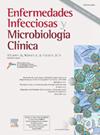Enhanced tick species identification in a tertiary care hospital using MALDI–TOF MS: The role of peak numbers
IF 2.5
4区 医学
Q3 INFECTIOUS DISEASES
Enfermedades infecciosas y microbiologia clinica
Pub Date : 2025-08-01
DOI:10.1016/j.eimc.2024.12.016
引用次数: 0
Abstract
Introduction
Tick bites are a growing public health concern as ticks act as vectors for various pathogens. Accurate tick species identification is vital to assess disease exposure and determine prophylactic measures. MALDI–TOF MS has emerged as a promising tool for precise tick identification. This study evaluates the performance of MALDI–TOF MS in clinical tick identification, focusing on how the number of peaks present in the reference and sample spectra influences the accuracy of the identification process.
Methods
Between April 2022 and March 2024, 42 tick specimens sent to our hospital were identified using MALDI–TOF MS. The reference spectrum was created with 70 peaks and expanded to include versions with 40, 100, and 130 peaks using Compass Biotyper Explorer v4.1.1. Spectra were analyzed with Flex Analysis v3.4 software. Identification was performed by querying sample spectra against these libraries, with a log score value (LSV) ≥ 1.70 considered accurate for species identification.
Results
Libraries with 40, 100, and 130 peaks improved identification scores for several species, though the degree varied. The highest scores were achieved in 64.3% of specimens. Combining all libraries as a single database yielded LSVs above the 1.70 threshold for all specimens.
Conclusions
The study highlights the species-specific nature of peak importance in spectra and underscores the potential of MALDI–TOF MS as a rapid and accurate tool for tick identification in clinical settings. Enhanced spectral libraries could further improve this technique, aiding timely clinical decisions and effective management of tick bites.
利用MALDI-TOF质谱增强三级保健医院蜱类鉴定:峰值数量的作用
蜱叮咬是一个日益严重的公共卫生问题,因为蜱是各种病原体的媒介。准确的蜱虫种类鉴定对于评估疾病暴露和确定预防措施至关重要。MALDI-TOF质谱已成为一种有前途的蜱虫精确鉴定工具。本研究评估了MALDI-TOF MS在临床蜱虫鉴定中的性能,重点关注参比光谱和样品光谱中存在的峰数如何影响鉴定过程的准确性。方法对2022年4月至2024年3月收治的42份蜱类标本采用MALDI-TOF ms进行鉴定,建立70个峰的参考光谱,并使用Compass Biotyper Explorer v4.1.1扩展到40、100和130个峰的版本。使用Flex Analysis v3.4软件对光谱进行分析。根据这些文库查询样品光谱进行鉴定,log score值(LSV)≥1.70被认为是准确的物种鉴定。结果有40、100和130个峰的文库提高了几种物种的识别分数,但程度不同。64.3%的标本达到最高分。将所有文库合并为一个数据库,所有标本的lsv均高于1.70阈值。结论该研究强调了光谱中重要峰的物种特异性,并强调了MALDI-TOF质谱作为临床环境中蜱虫快速准确鉴定工具的潜力。增强谱库可以进一步改进这一技术,帮助及时的临床决策和有效的管理蜱叮咬。
本文章由计算机程序翻译,如有差异,请以英文原文为准。
求助全文
约1分钟内获得全文
求助全文
来源期刊
CiteScore
2.10
自引率
8.00%
发文量
194
审稿时长
29 days
期刊介绍:
Hoy está universalmente reconocida la renovada y creciente importancia de la patología infecciosa: aparición de nuevos agentes patógenos, de cepas resistentes, de procesos con expresión clínica hasta ahora desconocida, de cuadros de una gran complejidad. Paralelamente, la Microbiología y la Infectología Clínicas han experimentado un gran desarrollo como respuesta al reto planteado por la actual patología infecciosa. Enfermedades Infecciosas y Microbiología Clínica es la Publicación Oficial de la Sociedad Española SEIMC. Cumple con la garantía científica de esta Sociedad, la doble función de difundir trabajos de investigación, tanto clínicos como microbiológicos, referidos a la patología infecciosa, y contribuye a la formación continuada de los interesados en aquella patología mediante artículos orientados a ese fin y elaborados por autores de la mayor calificación invitados por la revista.

 求助内容:
求助内容: 应助结果提醒方式:
应助结果提醒方式:


